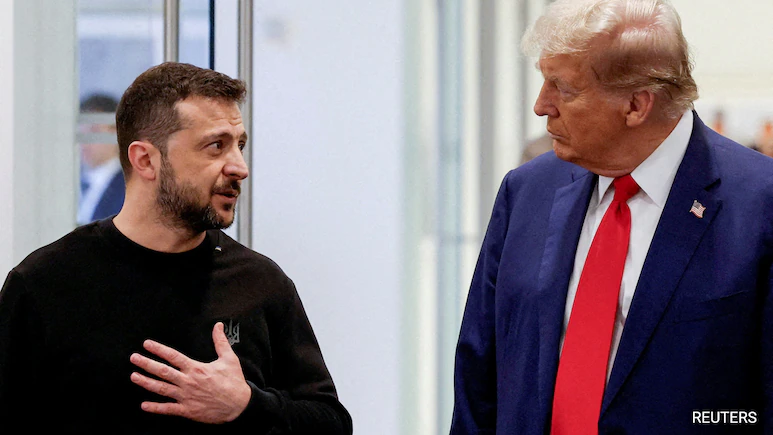US-Ukraine Reconstruction Deal Trump Secures Economic Gains
A New Era in U.S.-Ukraine Relations
On April 30, 2025, the United States and Ukraine signed the United States-Ukraine Reconstruction Investment Fund. The agreement, months in the making, combines support for Ukraine’s recovery with U.S. access to valuable minerals. It marks a strategic turn in bilateral ties under President Donald Trump.

This deal reflects a shift in U.S. foreign aid policy. Trump aims to mix economic benefits with geopolitical influence. The move has sparked both hope and criticism, with debates about its long-term effects on Ukraine’s recovery and the ongoing war with Russia.
Origins and Negotiation of the Deal
President Trump was the main driver of the agreement. He promoted it as a central part of his Ukraine policy. Talks began in early 2025 after a tense meeting in February between Trump and Ukrainian President Volodymyr Zelenskyy. That meeting ended with sharp words and the collapse of early plans.
Trump’s team, led by Treasury Secretary Scott Bessent, revived negotiations. They pushed for a deal that served both countries’ interests. The final agreement was signed by Bessent and Ukraine’s First Deputy Prime Minister Yulia Svyrydenko in Washington, D.C.
Ukraine’s need for funds shaped the deal. After three years of war with Russia, much of the country’s infrastructure lies in ruins. Recovery costs are estimated in the hundreds of billions. The U.S. has already given $175 to $350 billion in military and financial aid. Trump wanted to see economic returns on that investment.
Ukraine’s rich mineral deposits including graphite, aluminum, and rare earths offered common ground. However, early U.S. demands for $500 billion worth of these resources were rejected. A new 50-50 partnership was agreed upon. Ukraine retains full control over its resources, and the deal avoids new debt obligations.
Trump’s Strategy and Political Messaging
President Trump described the deal as “historic” and proof of his negotiation skills. The White House called it a first-of-its-kind partnership. It aims to ensure Ukraine’s recovery while providing economic benefits to the U.S.

Trump sent a dual message. He signaled continued U.S. support for Ukraine and promised that American taxpayers would see returns on foreign aid. He also warned that no Russian war supporters would profit from Ukraine’s rebuilding.
Trump’s broader strategy includes seeking peace between Ukraine and Russia. He believes economic recovery will give Ukraine more strength in talks. His emphasis on mutual benefit fits with his “America First” approach. Tying aid to economic value has caused friction with Kyiv but appeals to voters wary of endless overseas spending.
Immediate and Long-Term Impacts
The deal’s short-term impact is symbolic. Active war limits new mining and construction. Still, it lays the groundwork for future projects. The new fund will invest profits from Ukraine’s natural resources into rebuilding. The U.S. gains access to these resources, but profits in the first decade will go to Ukraine.
Prime Minister Denys Shmyhal emphasized that both sides will have equal voting rights. Ukraine maintains sovereignty over its assets. This clause was critical for securing domestic support for the deal.
Geopolitically, the deal shows the Trump administration’s commitment to a free and sovereign Ukraine. That message may increase pressure on Moscow. Trump has expressed frustration with Putin’s resistance to peace. The deal also places the U.S. in a leading role in Ukraine’s postwar future.
Ukraine’s parliament is expected to approve the agreement soon. Meanwhile, talks on operational details continue.
Mixed Reactions and Future Challenges
Reactions to the deal are mixed. President Zelenskyy’s team sees it as a way to keep U.S. support. Others warn that the agreement focuses too much on money and not enough on human loss. Oleksandra Matviichuk, a Nobel Peace Prize winner, said the deal risks an “incomplete peace.”
Some experts call the deal a “Band-Aid” solution. They argue it lacks the security guarantees Ukraine needs. CNN analysts say the focus on minerals may overlook the bigger picture of peace and justice.
Still, the deal could unlock Ukraine’s mineral potential. These resources are vital for global tech and manufacturing. A stable postwar environment will be key to its success.
For the U.S., the deal meets Trump’s goal of reducing aid costs and gaining strategic value. However, the delay in profits may frustrate parts of his political base. And without peace, the agreement’s economic promises remain uncertain.
The US-Ukraine Reconstruction Deal is a strategic effort to rebuild Ukraine while securing American interests. Initiated by Trump, it reflects a transactional foreign policy. The 50-50 partnership offers Ukraine economic hope without debt, while aligning with the U.S. push for returns on aid. But its real value depends on achieving peace a goal still out of reach.


 US Embassy in Tel Aviv Damaged as Iran’s Missile Strikes
US Embassy in Tel Aviv Damaged as Iran’s Missile Strikes  Iran’s Hypersonic Missiles Overwhelm Defenses
Iran’s Hypersonic Missiles Overwhelm Defenses  Elon Musk Pulls Back After Trump Post Controversy
Elon Musk Pulls Back After Trump Post Controversy  Is Trump Hyping Troops on U.S. Soil to Crush LA Protests?
Is Trump Hyping Troops on U.S. Soil to Crush LA Protests?  Did US Court Really Ban 11 Baby Names?
Did US Court Really Ban 11 Baby Names?